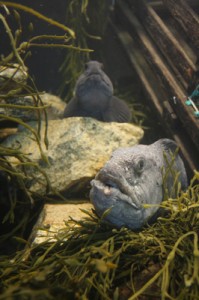Or, ugly fish are important, too
The wolffish may not win any beauty contests, but this species plays an important part in the marine ecosystem. Perceived by many people at first as ugly and even downright scary, the wolffish earns its name from its powerful jaws and the mouthful of teeth it uses to crush its prey, including sea urchins, mollusks and crustaceans.
Photo courtesy Maine State Aquarium, Aimee Hayden-Roderiques.
Kathleen Blanchard of Intervale Associates, Inc., produced the 21-minute film, Wolffish: A Balance of Life, primarily to help fish harvesters understand the ecological role of the wolffish. However, the film has appeal to all audiences with an interest in learning more about the marine environment. What makes the film unique is that the story is told from the perspective of fish harvesters.
In the film, educational information about the wolffish is framed by the harvesters’ perceptions. Viewers learn that wolffish behavior out of the water, where the harvesters encounter them, is quite aggressive, but that in their deep undersea habitats, they are quite docile. In addition, the wolffish helps control sea urchin populations, which left unchecked, will eat through kelp beds, akin to deforestation on land.
Three species of wolffish live in eastern Canada, all of which have experienced population declines: the northern wolffish, spotted wolffish, and Atlantic, or striped, wolffish. The northern wolffish and spotted wolffish are listed as threatened under Canada’s Species at Risk Act and the Atlantic wolffish is a species of special concern. The Atlantic wolffish, which lives in the Gulf of Maine on both sides of the border, is also listed as a species of special concern in the U.S.
Getting unintentionally caught in nets meant for other fish, or bycatch, by harvesters is a major human threat to wolffish populations. The idea for an educational video came to Blanchard after she had been working for years with harvesters on a stewardship project to help the recovery of the wolffish.
A few years into the project, surveys and dialogue with harvesters showed that most of them released wolfish alive, as required by Fisheries and Oceans Canada, but that they did not agree with the regulations, suggesting they perceived the fish as a nuisance with little value in putting it back in the ocean.
Blanchard wanted to build a sense of stewardship for the species. She thought that the best way to do this was to give harvesters the chance to voice their opinions and impressions of the wolffish both before and after learning more about them.
“We wanted to see the evidence that harvesters valued wolfish as part of the marine ecosystem, that stewardship was building,” said Blanchard.
The film has been presented to industry groups, universities, and fishery training programs. It’s also been used in schools. Pre- and post-viewing surveys have indicated that audiences’ perceptions broaden from focusing only on the fish’s looks to understanding the value the species plays.
To view the film online visit http://www.oceanicresearch.org/education/films/wolffish_film.htm
For ordering information contact Intervale Associates Inc. at info@intervale.ca
For more information about Atlantic wolfish, see the National Oceanic Atmospheric Administration fact sheet http://www.nmfs.noaa.gov/pr/pdfs/species/atlanticwolffish_detailed.pdf
Print



















